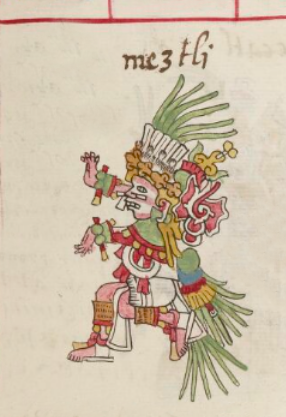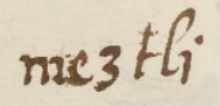Tecciztecatl Metztli (TR19r)
This example of iconography shows an anthropomorphized version of a divine force or deity Tecciztecatl, co-patron with Itzpapalotl over a particular trecena (13-day cycle in the divinatory calendar). The figure is shown in profile view, facing toward the viewer's left with his legs poised for movement, perhaps dance. The name is "Conch-Shell Person," and he has a cross-sectioned view of a conch shell/trumpet behind his head and a white shell ring on his chest. He also has many feather and flower ornamentations (one especially beautiful yellow flower on his headdress), pink stripes across if face, bracelets, sandals, bells on his legs, and more. The colors are pink, red, green, gold, brown, blue, and white.
Stephanie Wood
Eloise Quiñones Keber (Codex Telleriano-Remensis, 1995, 172) notes that the white shell ring on the chest of this co-patron of the particular trecena (13-day cycle in the divinatory calendar) suggests an association with the nocturnal force, Tetzcatlipoca. She also notes that this Tecciztecatl is not shown in other representations of this trecena, as the Borgia and Vaticanus B both have Tetzcatlipoca himself in this position.
Stephanie Wood (drawing from Eloise Quiñones Keber)
meztli
metztli
Stephanie Wood
ca. 1550–1563
Jeff Haskett-Wood
moons, lunas, meses, deidades, deities, shells, conchas, caracoles
Tecciztecatl Metztli, Conch-Shell deity, associated with a "month" or moon, https://nahuatl.wired-humanities.org/content/tecciztecatl-metztli
tecciz(tli), a conch shell, https://nahuatl.wired-humanities.org/content/tecciztli
-teca(tl), someone with a certain affiliation, https://nahuatl.wired-humanities.org/content/tecatl
metz(tli), month, https://nahuatl.wired-humanities.org/content/metztli
Caracol de la Mar, La Luna
(reproduciendo otras glosas en el manuscrito)
Telleriano-Remensis Codex, folio 19 recto, MS Mexicain 385, Gallica digital collection, https://gallica.bnf.fr/ark:/12148/btv1b8458267s/f63.item.zoom
The non-commercial reuse of images from the Bibliothèque nationale de France is free as long as the user is in compliance with the legislation in force and provides the citation: “Source gallica.bnf.fr / Bibliothèque nationale de France” or “Source gallica.bnf.fr / BnF.”




